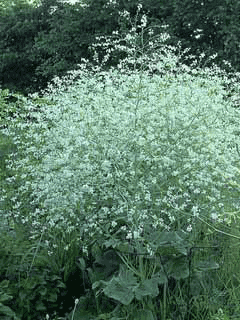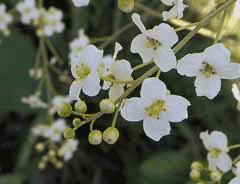 |
|
http://commons.wikimedia.org/wiki/User:Rasbak |
 |
| http://commons.wikimedia.org/wiki/User:Rasbak |
Translate this page:
Summary
Physical Characteristics

 Crambe cordifolia is a PERENNIAL growing to 2 m (6ft) by 1.2 m (4ft in).
Crambe cordifolia is a PERENNIAL growing to 2 m (6ft) by 1.2 m (4ft in).
See above for USDA hardiness. It is hardy to UK zone 6 and is not frost tender. It is in flower in June, and the seeds ripen in August. The species is hermaphrodite (has both male and female organs) and is pollinated by Insects.
Suitable for: light (sandy), medium (loamy) and heavy (clay) soils and can grow in nutritionally poor soil. Suitable pH: neutral and basic (mildly alkaline) soils. It can grow in semi-shade (light woodland) or no shade. It prefers dry or moist soil and can tolerate drought. The plant can tolerate maritime exposure.
UK Hardiness Map
US Hardiness Map
Synonyms
Plant Habitats
Ground Cover; Meadow;
Edible Uses
Edible Parts: Leaves Root
Edible Uses:
Leaves - cooked[2, 105, 177]. Used as a potherb[183]. Young leaves have a pleasant cabbage-like flavour, though older leaves are rather tough[K]. Root - cooked[2, 145, 177].
References More on Edible Uses
Medicinal Uses
Plants For A Future can not take any responsibility for any adverse effects from the use of plants. Always seek advice from a professional before using a plant medicinally.
Antipruritic
The plant is used as a cure for itch[240].
References More on Medicinal Uses
The Bookshop: Edible Plant Books
Our Latest books on Perennial Plants For Food Forests and Permaculture Gardens in paperback or digital formats.

Edible Tropical Plants
Food Forest Plants for Hotter Conditions: 250+ Plants For Tropical Food Forests & Permaculture Gardens.
More

Edible Temperate Plants
Plants for Your Food Forest: 500 Plants for Temperate Food Forests & Permaculture Gardens.
More

More Books
PFAF have eight books available in paperback and digital formats. Browse the shop for more information.
Shop Now
Other Uses
References More on Other Uses
Cultivation details
An easily grown plant, succeeding in a good loam and an open sunny position[1, 111, 200] but also tolerating some shade[188]. Prefers a slightly alkaline soil in a position sheltered from strong winds[200]. Another place in this report says that the plant tolerates maritime exposure[200]. Tolerates poor and dry soils and some shade[200]. Dislikes acid soils[1]. Established plants are drought tolerant[190]. Plants are hardy to about -20°c[187]. A deep-rooted plant[233], it dislikes root disturbance. The young growth in spring is adored by slugs[K]. Plants can be grown in the summer meadow if the grass is not cut too low, since this would damage the growing point[200]. The flowers emit a delicious wallflower-like scent in hot sunny weather[245].
References Carbon Farming Information and Carbon Sequestration Information
Temperature Converter
Type a value in the Celsius field to convert the value to Fahrenheit:
Fahrenheit:
The PFAF Bookshop
Plants For A Future have a number of books available in paperback and digital form. Book titles include Edible Plants, Edible Perennials, Edible Trees,Edible Shrubs, Woodland Gardening, and Temperate Food Forest Plants. Our new book is Food Forest Plants For Hotter Conditions (Tropical and Sub-Tropical).
Shop Now
Plant Propagation
Seed - sow March/April in a seedbed outdoors and either thin the plants out or move them to their permanent positions when about 10cm tall[111]. The young plants are very attractive to slugs so some protection will often be needed. Germination can be slow so it is best to sow the seed in pots in a cold frame[164]. Germination usually takes place in 3 - 26 weeks at 15°c[164]. Prick out the seedlings into individual pots as soon as they are large enough to handle and plant out into their permanent positions when they are at least 10cm tall. Division in spring or autumn[1, 111]. Dig up the root clump and cut off as many sections as you require, making sure they all have at least one growing point. The larger of these divisions can be planted out straight into their permanent positions, though small ones are best potted up and grown on in a cold frame until they are established. Root cuttings, 3 - 10 cm long, in spring[104]. These can be planted straight into the open ground or you can pot them up in the greenhouse and plant them out once they are growing strongly.
Other Names
If available other names are mentioned here
Flowering sea kale , Heart-leaved colewort, Greater sea-kale, Colewort,Heartleaf crambe
Native Range
TEMPERATE ASIA: Afghanistan, Iran, Azerbaijan, Kyrgyzstan, Tajikistan, Turkmenistan, Uzbekistan, China (Xinjiang Uygur Zizhiqu, Xizang Zizhiqu) TROPICAL ASIA: India (Himachal Pradesh), Pakistan
Weed Potential
Right plant wrong place. We are currently updating this section.
Please note that a plant may be invasive in one area but may not in your area so it's worth checking.
Conservation Status
IUCN Red List of Threatened Plants Status :

Growth: S = slow M = medium F = fast. Soil: L = light (sandy) M = medium H = heavy (clay). pH: A = acid N = neutral B = basic (alkaline). Shade: F = full shade S = semi-shade N = no shade. Moisture: D = dry M = Moist We = wet Wa = water.
Now available:
Food Forest Plants for Mediterranean Conditions
350+ Perennial Plants For Mediterranean and Drier Food Forests and Permaculture Gardens.
[Paperback and eBook]
This is the third in Plants For A Future's series of plant guides for food forests tailored to
specific climate zones. Following volumes on temperate and tropical ecosystems, this book focuses
on species suited to Mediterranean conditions—regions with hot, dry summers and cool, wet winters,
often facing the added challenge of climate change.
Read More
Expert comment
Author
Stev.
Botanical References
74200
Links / References
For a list of references used on this page please go here
Readers comment
© 2010, Plants For A Future. Plants For A Future is a charitable company limited by guarantee, registered in England and Wales. Charity No. 1057719, Company No. 3204567.